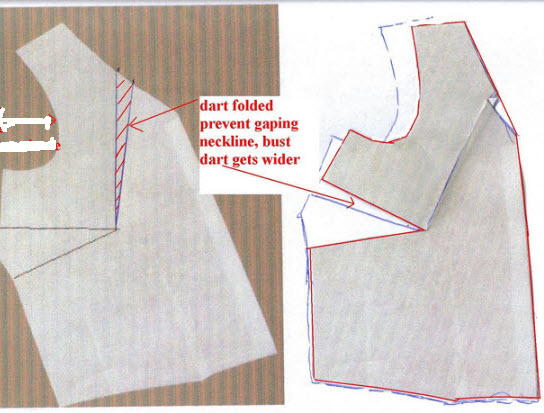Yesterday I said that few of us would say these sleeves aren’t a problem but the first problem is ___________ (fill in the blank). There was no shortage of responses, thank you everyone. The answer I was looking for was __the bodice__.
Specifically the front bodice. I stressed two other things yesterday as well:
- You have to know the order in which to fix the problem because
- There may be other problems that are not manifest until one issue is repaired.
I think most agree there’s two problems (bodice and sleeve), possibly a third (the back neck). It’s premature to talk about fixing that sleeve if you haven’t repaired the thing the sleeve is anchored to first. You can’t hopscotch around when fitting the anchoring of the bodice. Step one, step two, step three etc. Too many people want to apply too many fixes at once so you really don’t know what fixed what (for future reference) or where the problem is if a fitting issue remains.
Lesson: Don’t bother trying to repair a poorly fitted sleeve if you haven’t fixed the bodice. Once the bodice is together, then worry about the sleeve.
Here was my solution to this problem. I think the front bodice is too big at CF (those drag lines, pulling away from front neck etc). This is why (in part) the sleeves are falling backwards off the form. So, if this were my job, I’d make this first correction I’ve illustrated below.
Imagine this were a fold piece, I’ve taken out a dart at CF neck, tapering to zero at the hem.
It’s possible that the back would also need correcting but this wouldn’t be apparent until the front were corrected. Once those two were repaired (if both were needed) then the sleeve could get an overhaul. It’s definitely a pain to have to do this in two or three steps but it’s really the only way to pinpoint it.
Luckily for us, Clara (who asked the original question) is really on the ball. Between the time I posted the solution yesterday, she made the correction and sewed up another dummy. The result is below. Voila, drag lines are gone.
In the forum, Els posted another solution which was interesting for a couple of reasons. Maybe Clara will be a sport and try that one too. That one is below.
Tomorrow I will post her full solution which includes her analysis of the sleeve problem. Yeah Els!





I’d really like to see these shirts on a real person, especially with sleeves inserted.
It seems to me that the shape of the shoulders/arms on the dress form is distorting the top and that distortion is made a lot worse by those sleeves.
I must be weird, but I thought the blouse appears too NARROW across the bodice.
A huge thank you for pointing out that you need to fix the big things first and work your way out from there. Every designer should learn this in design 101. I am a tech who cooridinates with designers to give them the fit & look they desire. The number of times I have had to explain that the problems they are fussing over in a neck or sleeve etc. cannot really be seen until we first correct the bodice are countless. Large companies would save a lot of money on fit models if they made sure their designers understood this, so the techs could work more efficiently during fittings.
My spontaneous impression is that the front neck width (?) is too small compared to the back, so that when shoulders are joined the back neck “pushes out” the front neck line and makes it look like there’s too much fabric there. It makes one want to do the correction Els suggested, but it would only worsen the problem, I think. I believe the necessary correction would be to do the opposite – not moving the front neck point closer to center front but further away.